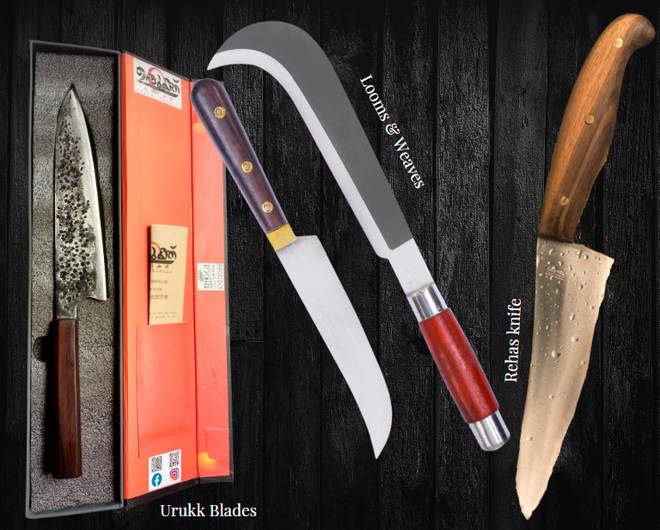Staring at my cache of 24 knives arranged in a menacing phalanx on the dining table, I ask myself: am I a collector or a hoarder? Neither, for I lack the compulsive passion of a collector who would go to extreme lengths to acquire a rare piece, nor am I a profiteer waiting for the opportune moment to sell my wares. Scratch out butcher, chef, and superhero, and that leaves just one option — a pack rat. Someone who saves things that are never really used, but have a personal value.
The ensemble, to be brutally honest, cuts a sorry figure. Unearthed from a corner of the shelf below the kitchen sink, they have been languishing for years with fungus, rust, and unknown bacteria coating their surfaces.
Each one is a gift from my mother, and their neglect cuts through me like a knife. Every time I visited, she would hand me a glistening knife on a platter, along with the bottles of homemade pickle and chips that I craved.
Incognito bodyguards
The first three are family ‘silver’, and were part of my trousseau. They are ‘Sheffield-Made in England’ bread, fruit and vegetable knives, which were cherry-picked from my mother’s cutlery cupboard and placed into my blue Aristocrat suitcase. They have rosewood handles with copper nubs instead of nails, and despite my disregard for them, their steel blades are, even now, after several decades, still ‘stainless’ steel. They accompanied me to every new home I moved into, serving as incognito bodyguards.
I looked upon their growing number with benign sentimentality until recently, when Google took me on an educational tour. How complacent of me to relegate them as bits of metal ready for the scrapyard when, in fact, the ‘Sheffield-Made in England’ were rare gems created by highly skilled craftsmen? The first reference to a Sheffield cutler dates to 1297. In the 1380s, Geoffrey Chaucer described a Sheffield ‘thwitel’ (a straight wood-handled knife) on the belt of a miller in The Reeve’s Tale.
On another visit to mother’s, I was gifted a couple of ‘The Slack & Barlow’ (incorporated in 1947) table knives, with silver handles that are crying out now for a vigorous shine. Then there is the Rostfrei Solingen with a cream faux bone handle, which I whip out when the local Iyengar baker hands over an unsliced loaf of bread. Again, research reveals that Rostfrei is the German descriptive word for a knife made from stainless steel. Most of the knives originate from the town of Solingen, and some vintage ones date to 1912.
One for every occasion
Let’s put aside the European tableware and focus on the more rustic but equally efficient Kerala pichathi. Made of iron, and prone to rust when not in use, there’s one for every occasion: from peeling mangoes to slicing jackfruit, to chopping meat, to cutting fish. If employed unwisely, such as using the pichathi for cutting vegetables to crack a coconut, the blade gets warped or broken. To get a replacement with that ideal grip and brass hilt is well-nigh impossible.
For all things coconut, you need a vettukathi, with a wooden handle and a curved blade that easily hooks onto a tree trunk when the user wants to smoke a beedi. I have that one too, but I don’t smoke.
The one for daily use cuts as precisely as the Mumbai sandwichwala’s onion knife — clean horizontal and vertical slices. The four more-recently gifted Ikea knives grace the kitchen top in their designated holder, while the brand’s magnetic holder displays to perfection my lethal ware.
Last but not the least is the hand-stitched scabbard-sheathed khukhri, a Gurkha army issue, which is positioned a foot from the front door. It has a stubborn clasp, but that’s not a problem. Now do you wonder why my guests are few and far between?

On the cutting edge
The writer is based in Bengaluru.







